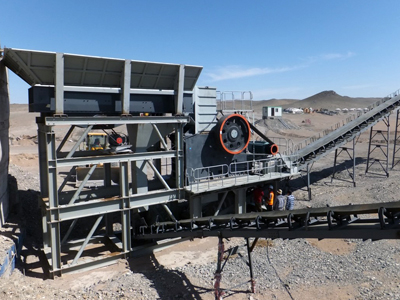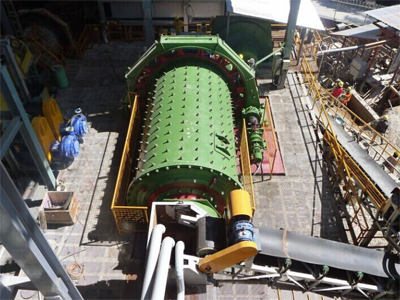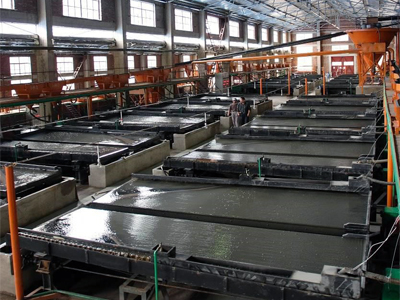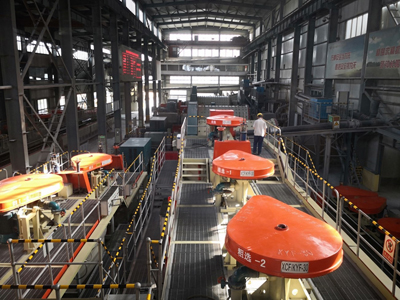-
Address: N0.2555,Xiupu Road, Kangqiao
Industrial Area, Pudong, Shanghai -
Call Us: (+86) 021-51095338
[email protected]
Iron ore is the key raw material for steel production enterprises. Generally, iron ore with a grade of less than 50% needs to be processed before smelting and utilization.
After crushing, grinding, magnetic separation, flotation, and gravity separation, etc., iron is gradually selected from the natural iron ore. The beneficiation process should be as efficient and simple as possible, such as the development of energy-saving equipment, and the best possible results with the most suitable process. In the iron ore beneficiation factory, the equipment investment, production cost, power consumption and steel consumption of crushing and grinding operations often account for the largest proportion. Therefore, the calculation and selection of crushing and grinding equipment and the quality of operation management are to a large extent determine the economic benefits of the beneficiation factory.
There are many types of iron ore, but mainly magnetite (Fe3O4) and hematite (Fe2O3) are used for iron production because magnetite and hematite have higher content of iron and easy to be upgraded to high grade for steel factories.
Importance of mineralogy study
Due to the deformation of the geological properties, there would be some changes of the characteristics of the raw ore and sometimes magnetite, hematite, limonite as well as other types iron ore and veins are in symbiosis form. So mineralogy study on the forms, characteristics as well as liberation size are necessary before getting into the study of beneficiation technology.
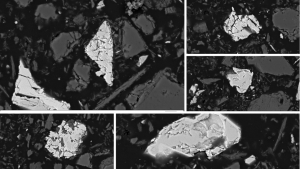
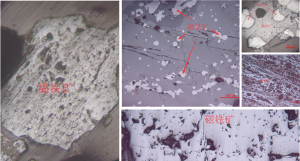
Processing technologies of magnetite and hematite ore
1. Magnetite ore stage grinding-magnetic separation process
The stage grinding-magnetic separation process mainly utilizes the characteristics of magnetite that can be enriched under coarse grinding conditions, and at the same time, it can discharge the characteristics of single gangue, reducing the amount of grinding in the next stage.
In the process of continuous development and improvement, the process adopts high-efficiency magnetic separation equipment to achieve energy saving and consumption reduction. At present, almost all magnetic separation plants in China use a large-diameter (medium 1 050 mm, medium 1 200 mm, medium 1 500 mm, etc.) permanent magnet magnetic separator to carry out the stage tailing removing process after one stage grinding. The characteristic of permanent magnet large-diameter magnetic separator is that it can effectively separate 3~0mm or 6~0mm, or even 10-0mm coarse-grained magnetite ore, and the yield of removed tails is generally 30.00%~50.00%. The grade is below 8.00%, which creates good conditions for the magnetic separation plant to save energy and increase production.
2.Magnetic separation-fine screen process
Gangue conjoined bodies such as magnetite and quartz can be enriched when the particle size and magnetic properties reach a certain range. However, it is easy to form a coarse concatenated mixture in the iron concentrate, which reduces the grade of the iron concentrate. This kind of concentrate is sieved by a fine sieve with corresponding sieve holes, and high-quality iron concentrate can be obtained under the sieve.

Typical flowchart of magnetite beneficiation plant
There are two methods for gravity separation of hematite. One is coarse-grained gravity separation. The geological grade of the ore deposit is relatively high (about 50%), but the ore body is thinner or has more interlayers. The waste rock is mixed in during mining to dilute the ore. For this kind of ore, only crushing and no-grinding can be used so coarse-grained tailings are discarded through re-election to recover the geological grade.
The other one is fine-grain gravity separation, which mostly deals with the hematite with finer grain size and high magnetic content. After crushing, the ore is ground to separate the mineral monomers, and the fine-grained high-grade concentrate is obtained by gravity separation. However, since most of the weak magnetic iron ore concentrates with strong magnetic separation are not high in grade, and the unit processing capacity of the gravity separation process is relatively low, the combined process of strong magnetic separation and gravity separation is often used, that is, the strong magnetic separation process is used to discard a large amount of unqualified tailings, and then use the gravity separation process to further process the strong magnetic concentrate to improve the concentrate grade.

Typical flowchart of hematite beneficiation plant
Due to the complexity, large-scale mixed iron ore and hematite ore adopt stage grinding or continuous grinding, coarse subdivision separation, gravity separation-weak magnetic separation-high gradient magnetic separation-anion reverse flotation process. The characteristics of such process are as follows:
(1) Coarse subdivision separation: For the coarse part, use gravity separation to take out most of the coarse-grained iron concentrate after a stage of grinding. The SLon type high gradient medium magnetic machine removes part of the tailings; the fine part uses the SLon type high gradient strong magnetic separator to further remove the tailings and mud to create good operating conditions for reverse flotation. Due to the superior performance of the SLon-type high-gradient magnetic separator, a higher recovery rate in the whole process is ensured, and the reverse flotation guarantees a higher fine-grained concentrate grade.
(2) A reasonable process for narrow-level selection is realized. In the process of mineral separation, the degree of separation of minerals is not only related to the characteristics of the mineral itself, but also to the specific surface area of the mineral particles. This effect is more prominent in the flotation process. Because in the flotation process, the minimum value of the force between the flotation agent and the mineral and the agent and the bubble is related to the specific surface area of the mineral, and the ratio of the agent to the mineral action area. This makes the factors double affecting the floatability of minerals, easily causing minerals with a large specific surface area and relatively difficult to float and minerals with a small specific surface area and relatively easy to float have relatively consistent floatability, and sometimes the former has even better floatability. The realization of the narrow-level beneficiation process can prevent the occurrence of the above-mentioned phenomenon that easily leads to the chaos of the flotation process to a large extent, and improve the beneficiation efficiency.
(3) The combined application of high-gradient strong magnetic separation and anion reverse flotation process achieves the best combination of processes. At present, the weak magnetic iron ore beneficiation plants in China all adopt high-gradient strong magnetic separation-anion reverse flotation process in their technological process. This combination is particularly effective in the beneficiation of weak magnetic iron ore. For high-gradient strong magnetic separation, the effect of improving the grade of concentrate is not obvious. However, it is very effective to rely on high-gradient and strong magnetic separation to provide ideal raw materials for reverse flotation. At the same time, anion reverse flotation is affected by its own process characteristics and is particularly effective for the separation of fine-grained and relatively high-grade materials. The advantages of high-gradient strong magnetic separation and anion reverse flotation technology complement each other, and realize the delicate combination of the beneficiation process.
(4) The high-efficiency anion reverse flotation process greatly improves the beneficiation index. This is because anion reverse flotation has a higher beneficiation efficiency.

Typical flowchart of hematite beneficiation plant
1.1 Brief Introduction
The key technology innovation of the integrated dry grinding and magnetic separation system is to "replace ball mill grinding with HPGR grinding", and the target is to reduce the cost of ball mill grinding and wet magnetic separation.
Typical Flowchart:
The HPGR → Air Classifier → Air Magnetic Separation Cluster
The HPGR→ Air Magnetic Separation Cluster →Air Classifier
1.2 Strip Surface HPGRs
HPGRs or high-pressure grinding rolls have made broad advances into mining industries. The technology is now widely viewed as a primary milling alternative, and there are several large installations commissioned in recent years. After these developments, an HPGRs based circuit configuration would often be the base case for certain ore types, such as very hard, abrasive ores.
The wear on a roll’s surface is a function of the ore’s abrasivity. Increasing roll speed or pressure increases wear with a given material. Studs allowing the formation of an autogenous wear layer, edge blocks, and cheek plates. Development in these areas continues, with examples including profiling of stud hardness to minimize the bathtub effect (wear of the center of the rolls more rapidly than the outer areas), low-profile edge blocks for installation on worn tires, and improvements in both design and wear materials for cheek plates.
With Strip Surface, HPGRs improve observed downstream comminution efficiency. This is attributable to both increased fines generation, but also due to what appears to be weakening of the ore which many researchers attribute to micro-cracking.
As we tested , the average yield of 3mm-0 and 0.15mm-0 size fraction with Strip Surface was 78.3% and 46.2%, comparatively, the average yield of 3mm-0 and 0.3mm-0 with studs surface was 58.36% and 21.7%.
Particle Size Distribution of A HPGR Product
| Strip Surface HPGR | Studs Surface HPGR | ||
| Size /mm | Yield/% | Size /mm | Yield /% |
| >20 | 0 | >20 | 1.63 |
| 20-10 | 0 | 20-10 | 7.51 |
| 10-5 | 13.71 | 10-5 | 18.95 |
| 5-3 | 7.97 | 5-3 | 13.55 |
| 3-1 | 13.07 | 3-1 | 16.97 |
| 1-0.5 | 10.21 | 1-0.3 | 19.69 |
| 0.5-0.15 | 15.9 | 0.3-0.074 | 11.31 |
| 0.15-0.074 | 9.87 | ||
| <0.074 | 29.27 | <0.074 | 10.39 |
1.3 Gravitational Air Classifier
These intelligently engineered units are ideal for classifying coarser cuts ranging from 50 to 200 mesh. The feed material is dropped into the top of the classifier. It falls into a continuous feed curtain in front of the vanes, passing through low velocity air entering the side of the unit. The air flow direction is changed by the vanes from horizontal to angularly upward, resulting in separation and classification of the particulate. Coarse particles dropps directly to the product and fine particles are efficiently discharged through a valve beneath the unit. The micro fines are conveyed by air to a fabric filter for final recovery.

Gravitational Air Classifier Working Principle
1.4 Air Magnetic Separation Cluster
Air Magnetic Separation Cluster is a special equipment developed for dry magnetic separation of fine size (-3mm) and micro fine size(-0.1mm) magnetite. The air magnetic separation system can be combined according to the characteristic of magnetic minerals to achieve effective recovery of magnetite.
Air Magnetic Separation Cluster performance: tailings mFe grade can be controlled below 0.5% and concentrate Fe grade can reach to 60% - 68% (depending on the liberation of magnetite) .
Air Magnetic Separation Cluster Working Principle
1.5 Cases

Cases 1 - 0.6 Mtpa Magnetite Integrated Dry Grinding and Magnetic Separation System in Xinjiang, China
Technical specifications:
| Items | Description | Unit | Value |
| 1 | Feeding Size | mm | 25-30 |
| 2 | Feed TFe Grade | % | 25-27 |
| 3 | Concentrate TFe Grade | % | 61.5-64.5 |
| 4 | Tailing TFe Grade | % | 6.8-7.2 |
| 5 | Concentrate Yield | % | 31-37 |
| 6 | TFe Recovery | % | 81-84 |
| 7 | mFe Recovery | % | 95-96 |
| 8 | Power Consumption | - | ≤14 kWh/t raw ore |

Strip Surface HPGRs+ Air Magnetic Separation Cluster+ Gravitational Air Classifier

Cases 2 - 0.5 Mtpa Magnetite Integrated Dry Grinding and Magnetic Separation System in Myanmar

Cases 3 - 0.8 Mtpa Magnetite Integrated Dry Grinding and Magnetic Separation System in Mongolia

Cases 4 - 4 Mtpa Magnetite Integrated Dry Grinding and Magnetic Separation System in Hebei, China
Characteristics of the iron ore processing technology in recent years
1. Pre-separation process
- (1) Pre-separation of low grade magnetite ore.
The successful development and application of big lump ore dry permanent magnetic separators and high-efficiency magnetic drums (magnetic pulleys) have enabled the beneficiation of low grade magnetite ore to discard 10% to 30% of tailings in advance, and improve the ore into the grinding grade 2-5% has played a great role in reducing the load in the grinding stage, improving the grinding efficiency, and saving energy and reducing consumption. - (2) Pre-separation of weakly magnetic iron ore.
The coarse-grain permanent magnetic roller-type strong magnetic separator can obtain a coarse concentrate with an iron grade of 32% -34% and a tailing grade of 10%-12% under the conditions of a feed size of 20-2 mm and a feed grade of 24%-26%.
2. Stagegrinding and stage separation process
After rough grinding, adopt appropriate separation method, discard part of tailings and sort out part of qualified concentrate, and re-grind and re-separate the middling, is called stage grinding and stage separation process.
According to the characteristics of the raw ore, the use of stage grinding and stage separation technology is an effective measure for energy conservation in iron ore concentrators. At the coarser one-stage grinding fineness, high-efficiency beneficiation equipment is used to advance the tailings, which greatly reduces the processing volume of the second-stage grinding.
3. Fine screen regrinding process
If the crystal grain size is relatively coarse, the stage grinding, stage magnetic separation-fine sieve self-circulation process is adopted. Generally, the product on the fine sieve is given to the second stage grinding and re-grinding. The process flow is relatively simple.
If the crystal grain size is too fine, the process of stage grinding, stage magnetic separation and fine sieve regrind is adopted. This process is the third stage of grinding and fine grinding after the products on the first and second stages of fine sieve are concentrated and magnetically separated. Then it is processed by magnetic separation and fine sieve, the process is relatively complicated.
4. Magnetic separation-reverse flotation process
At present, the operation of magnetic separation (including weak magnetic separation and strong magnetic separation) is one of the effective means of throwing tails in advance; anion reverse flotation and cation reverse flotation are one of the effective means to improve the grade of iron ore.
In particular, in the process of beneficiation, both of them basically take the selected feed minerals containing less gangue minerals as the sorting object, and both use the biggest difference in mineral selectivity, which makes the two in the whole process both play a good role in the process.
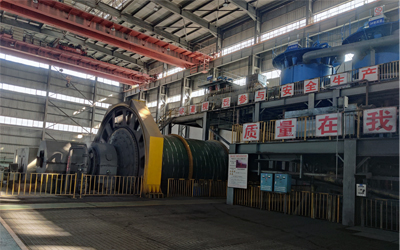
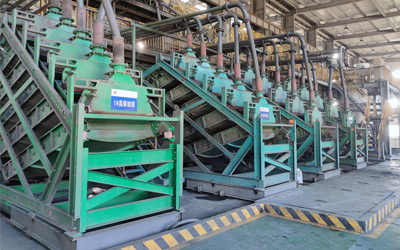
Based on the iron ore processing experience and necessary processing tests, Prominer can supply complete processing plant combined with various processing technologies, such as gravity separation, magnetic separation, flotation, etc., to improve the grade of TFe of the concentrate and get the best yield. Magnetic separation is commonly used for magnetite. Gravity separation is commonly used for hematite. Flotation is mainly used to process limonite and other kinds of iron ores
Through detailed mineralogy study and lab processing test, a most suitable processing plant parameters will be acquired. Based on those parameters Prominer can design a processing plant for mine owners and supply EPC services till the plant operating.




